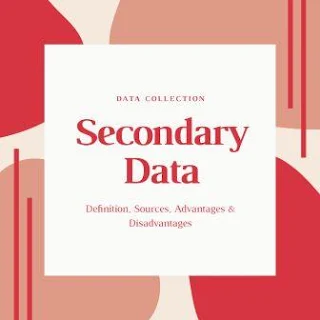What is Secondary Data in Statistics | Sources, Examples, Merits & Demerits
Statistical Data Types:
Data Collection:
- Any statistical data can be classified under two categories depending upon the sources utilized.
These categories are,
1. 1. Primary Data 2. Secondary Data
Secondary Data:
What is secondary data in statistics?
Secondary data are those data
which have been already collected and analysed by some earlier agency for its
own use; and later the same data are used by a different agency. According to W.A.Neiswanger,
‘ A primary source is a publication in which the data are published by the same
authority which gathered and analysed them. A secondary source is a
publication, reporting the data which have been gathered by other authorities
and for which others are responsible’.
 |
| Secondary Data |
Secondary Data Sources:
In most of the studies the
investigator finds it impracticable to collect first-hand information on all
related issues and as such he makes use of the data collected by others. There
is a vast amount of published information from which statistical studies may be
made and fresh statistics are constantly in a state of production.
What are the main sources of secondary data?
The sources of secondary data can broadly be classified under two heads:
1. Published sources, and
2. Unpublished sources.
1. Published Sources:
The various sources of published
data are:
1. Reports and official
publications of
(i) International bodies such as
the International Monetary Fund, International Finance Corporation and United Nations
Organisation.
(ii) Central and State
Governments such as the Report of the Tandon Committee and Pay Commission.
2. Semi-official publication of various local bodies such as Municipal Corporations and District Boards.
3. Private publications-such as the publications of –
(i) Trade and professional bodies
such as the Federation of Indian Chambers of Commerce and Institute of Chartered
Accountants.
(ii) Financial and economic
journals such as ‘Commerce’, ‘Capital’ and ‘Indian Finance’.
(iii) Annual reports of joint
stock companies.
(iv) Publications brought out by
research agencies, research scholars, etc.
It should be noted that the publications mentioned above vary with regard to the periodically of publication. Some are published at regular intervals (yearly, monthly, weekly etc.,) whereas others are ad hoc publications, i.e., with no regularity about periodicity of publications.
Note: A lot of
secondary data is available in the internet. We can access it at any time for
the further studies.
2. Unpublished Sources:
All statistical material is not
always published. There are various sources of unpublished data such as records
maintained by various Government and private offices, studies made by research institutions,
scholars, etc. Such sources can also be used where necessary.
Precautions in the use of Secondary data:
The following are some of the
points that are to be considered in the use of secondary data
1. How the data has been
collected and processed
2. The accuracy of the data
3. How far the data has been
summarized
4. How comparable the data is
with other tabulations
5. How to interpret the data,
especially when figures collected for one purpose is used for another Generally
speaking, with secondary data, people have to compromise between what they want
and what they are able to find.
Merits and Demerits of Secondary Data:
Advantages and Disadvantages of Secondary data as follows
1. Secondary data is cheap to
obtain. Many government publications are relatively cheap and libraries stock quantities
of secondary data produced by the government, by companies and other
organisations.
2. Large quantities of secondary
data can be got through internet.
3. Much of the secondary data
available has been collected for many years and therefore it can be used to
plot trends.
4. Secondary data is of value to:
- The government – help in making
decisions and planning future policy.
- Business and industry – in
areas such as marketing, and sales in order to appreciate the general economic and
social conditions and to provide information on competitors.
- Research organisations – by
providing social, economical and industrial information.
